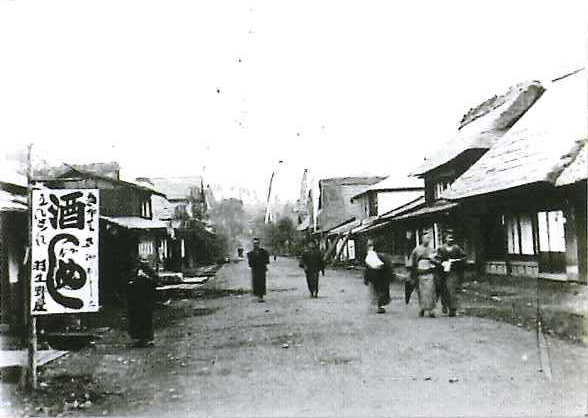
箱根そばの看板
(万延元年〔1860〕。箱根銘産とあり。)
Signboard for Hakone buckwheat noodles
(Circa 1860, described as a local Hakone specialty) |
| |

かつての箱根宿の町並
(明治35年頃。まだ江戸時代当時の町並みを残している。)
Townscape of the former Hakone post station
(Circa 1902. The streetscape preserves features of the Edo period.) |
| |
| 天正18年(1590年)、豊臣秀吉が天下を統一し、徳川家康が三河国から関東に移封になった。家康は江戸城を居城とし、城周辺の整備を進める。江戸城は大改修され、建物外壁の造成のために大量の漆喰が必要となり、現青梅市成木で産する石灰が建材として運ばれた。このために整備されたのが、青梅から江戸を結ぶ瑞穂町内を東西に走る大江戸街道で、箱根ケ崎村は石灰運搬の中継地となった。現青梅街道(下街道)でも石灰は運ばれたようである。このころ、現元狭山地区大字富士山では、新田開発が行われたようで、近世初期の古新田集落として富士山村が成立したようである。 | In 1590, Hideyoshi Toyotomi unified Japan and Ieyasu Tokugawa was forced to relocate from Mikawa Province to Kanto. Ieyasu made Edo castle his residence and went on to develop the area around the castle. Edo Castle underwent extensive renovation, which involved a considerable amount of plastering when constructing the building’s exterior wall, and lime produced in Nariki in the present Ome city was a building material carried to Edo. For this purpose, the Oedo-kaido highway was developed to link Edo and Ome, running through today’s Mizuho east to west, and Hakonegasaki village became a transit point for the transport of lime. Lime seemed to have been carried even through the current Ome-kaido Road (i.e., Shimo-kaido). Around that time, a development of new rice paddies seemed to have been carried out in the present Oaza Fujiyama of Motosayama district, and Fujiyama village was established as a Koshinden (the rice paddies developed between 1688-1735 AD) community of early modern times. |
| 慶安5年(1652年)、八王子千人同心の日光勤番が始まり、同心達の往来の道として日光街道が整備された。二街道沿線上の箱根ケ崎村は、幕府より同心達の人馬継立を申し付けられ、宿場町として繁栄した。同様に、入間郡側の二本木村も街道沿線上の宿場町として繁栄した。 | In 1652, Hachioji Sen'nin Doshin (the Thousand Police Constables of Hachioji) began to take it in turn to guard Nikko, and the Nikko-kaido highway was developed as a road for their use. Hakonegasaki village, which was on the two highways, was told by the shogunate to provide men and horses to work in relay for the constables, and it went on to prosper as a post town. Similarly, Nihongi village of the Iruma-gun district also grew wealthy as a post town along the same highway. |
| 江戸時代中期になると、八代将軍徳川吉宗が新田開発を奨励したことから、瑞穂町域でも新田開発がさかんに行われた。長岡地区の大字長岡長谷部、大字長岡下師岡、元狭山地区の富士山栗原新田はこの頃新田集落として成立した。 | In the mid-Edo period, because the eighth shogun, Yoshimune Tokugawa, encouraged new rice paddies (shinden), they were also actively developed in the Mizuho area. Oaza Nagaoka-Hasebe and Oaza Nagaoka-Shimomoro'oka of the Nagaoka district and Fujiyama-Kurihara Shinden of the Motosayama district were established at that time as villages associated with the new-rice paddies. |
| 江戸時代後期には、江戸地廻り経済の発展に伴い、江戸周辺地域では換金目的で商品作物を栽培し、江戸へ出荷するようになった。瑞穂一帯では夏そばが栽培され、箱根ケ崎に集荷されて江戸へ出荷された。これは「箱根そば」として人気を博した。また現元狭山地区、旧入間郡坊村の村野弥七盛政は、隣の入間郡宮寺村の吉川忠八温恭(よしずみ)とともに狭山茶を創製し、狭山丘陵北麓側で茶の生産が盛んとなった。 | In the late Edo period, with the development of the local economy surrounding Edo, some of those who lived around the periphery of Edo began to grow commercial crops and shipped to the city. In the Mizuho area, summer buckwheat was cultivated, and collected in Hakonegasaki and traded in Edo. This gained popularity as "Hakone buckwheat noodle". Also, Morimasa Yashichi Murano of Bo village in the old Iruma-gun district (the present Motosayama district) created Sayama tea by starting cultivation of this crop with Yoshizumi Chuhachi Yoshikawa, and tea production thrived on the northern foot of Sayama Hill. |